Understanding Tarot Card Reading Layouts and Their Impact
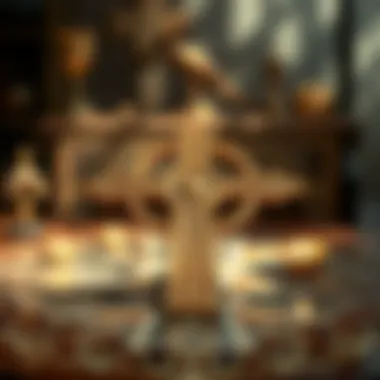
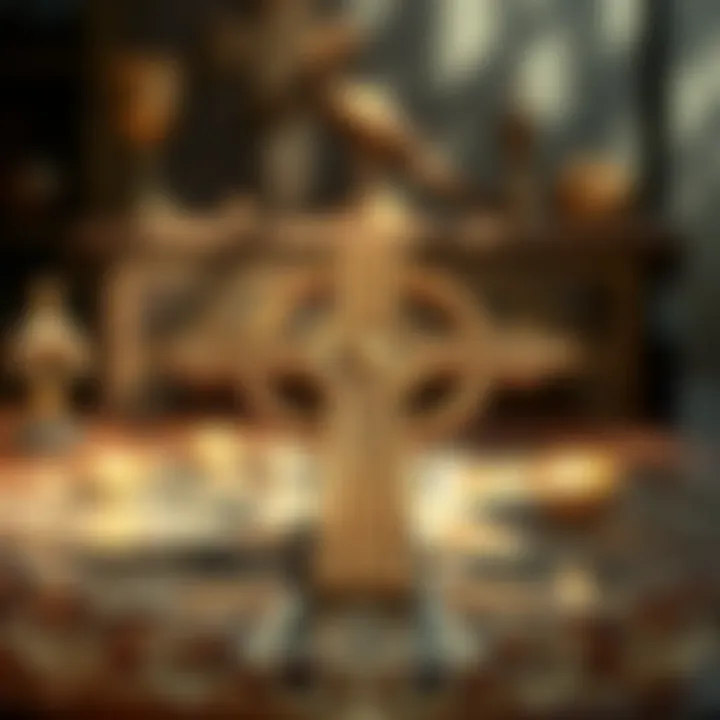
Intro
The art of tarot card reading is steeped in history and mystique, offering insights that can lead to profound self-discovery and awareness. Amidst the myriad of tarot practices, the layout, or formation, of cards plays a pivotal role in shaping the information derived from each reading. Various formations, like the Celtic Cross or the Three-Card Spread, are not just random arrangements; they carry unique meanings that can illuminate different aspects of one's life.
In this article, we'll delve into these diverse tarot formations, deciphering their significance and how they can guide seekers on their journeys. By the end, you’ll gain a clearer understanding of these arrangements to help enhance your own tarot practice, fostering deeper insights and more informed decisions along the way.
Understanding Tarot Card Formations
Before diving into specific formations, it’s important to grasp the underlying principles behind tarot reading itself. Each card holds unique symbolism, and the way they are laid out creates a narrative that reflects the inquirer's reality. Just like different spices can change the flavor of a dish, the arrangement of cards alters the interpretation of their meanings.
Some tarot readers might prefer a simple three-card spread, useful for quick guidance on a specific question or situation. Others may gravitate toward complex layouts that reveal multifaceted insights, such as the Celtic Cross, which can address past, present, and future dynamics in greater depth.
In the sections to follow, we will explore prominent tarot formations in detail, elucidating their meanings, optimal contexts for use, and how they can be empowering tools on one’s path to clarity and self-awareness.
Understanding Tarot Card Basics
Understanding the fundamentals of tarot cards lays a solid foundation for any exploration into readings and formations. Grasping the core elements not only enhances one's appreciation of tarot but also enriches the readings themselves. By familiarizing ourselves with the history, structure, and intuitive elements, we can better navigate the intricate world of tarot.
The History of Tarot
Tarot's roots can be traced back to the 15th century in Europe, primarily as a card game called tarocchi. These decks were adorned with symbols and imagery that reflected the cultural dynamics of the time. Over the centuries, tarot transformed, evolving from simple game cards to tools for divination and self-reflection. The transition marked a significant shift in perception; no longer just entertainment, tarot began to serve as a mirror of human experience.
This historical context reveals how tarot has absorbed various cultural influences, adapting to different spiritual and philosophical perspectives. From the mystic traditions of the Kabbalah to the symbolic language of alchemy, each layer of history adds depth to the practice today. Understanding this historical backdrop enhances our readings, as it allows for a richer interpretation of the cards.
The Structure of a Tarot Deck
A traditional tarot deck typically consists of 78 cards, cleverly categorized into two main groups: Major Arcana and Minor Arcana. This structural split is vital for understanding how each card functions within a reading, as well as its significance in the greater narrative.
Major Arcana
The Major Arcana includes 22 cards, each representing significant life lessons and archetypal themes. These cards are often viewed as the heart and soul of tarot, where deeper, universal truths come into play. Not only do they symbolize pivotal moments in one’s journey, but they also speak to the collective human experience.
Considered a beneficial choice for this exploration, the Major Arcana captures the highs and lows we face, such as The Fool (new beginnings) or The Tower (sudden upheaval). Their unique feature lies in their ability to convey profound messages, often stirring deep emotional responses, making them essential in interpreting readings.
Minor Arcana
In contrast, the Minor Arcana consists of 56 cards that delve into the day-to-day experiences of life. They are divided into four suits: Cups, Pentacles, Swords, and Wands, each associated with various aspects of existence such as emotions, material wealth, conflict, and creativity. The Minor Arcana provides a more granular view, bringing context to the overarching themes presented by the Major Arcana.
These cards are popular for those seeking insights into the minutiae of life, offering guidance on issues ranging from relationships to career choices. Their unique advantage lies in their diversity and detail, addressing not only the grand narratives but also the small, yet vital, choices we make every day.
Suits and Court Cards
Within the framework of the Minor Arcana, the suits and court cards serve as vital components. Each suit represents a specific element and energy, while court cards illustrate personalities or roles.
The Cups, for example, connect to emotions and intuition. The Court Cards, such as the Page of Cups or the King of Wands, represent the various dimensions of human experience, guiding querents in understanding their situations or decisions. The distinctiveness of court cards allows for personalization in readings, amplifying the interactive nature of tarot.
By understanding these structural elements of tarot, one can better navigate the complexities of readings and make informed interpretations. Knowledge of the deck's architecture contributes to clarity and enhances overall experience.
The Role of Intuition in Tarot Reading
Intuition plays a crucial role in tarot reading, acting as a bridge between the cards and the reader's personal insight. While knowledge of the cards is necessary, it is the intuitive connection that often leads to the most revealing interpretations. Embracing one’s intuitive self can unlock layers of meaning that book definitions might miss. As readers develop their intuition, they enable richer conversations with the tarot, fostering deeper understanding and guidance throughout their journey.
The Importance of Layouts in Tarot Readings
Tarot reading is not merely about the cards themselves; the configurations in which these cards are laid out, known as layouts or spreads, are equally vital. Understanding the significance of these formations can enhance a reader's ability to convey insights and intuitively grasp the nuances behind the cards. Simply put, card layouts help establish a structured dialogue between the reader and the deck, creating a framework that guides interpretation.
Layouts serve several key functions that impact the depth and clarity of a reading:
- Clarity and Focus: Each card's position within a layout provides context that sharpens the meaning of it. For instance, a card representing challenges may take on different connotations depending on whether it appears at the beginning or towards the end of a spread. Every position carries its own weight, allowing for a multi-dimensional understanding of the query at hand.
- Enhanced Insight: The positioning not only affects individual card meanings but can also unveil connections among them. When cards interact within their designated spots, they may reveal patterns, conversely highlighting underlying themes or energies at play. This interplay cultivates a richer narrative.
- Guided Interpretation: For both novice and seasoned readers, layouts act as a roadmap during readings. They provide a guideline for what to focus on—the past, the present, the future, or specific areas like career or relationships. This directional approach can lead to more informed questions and clearer answers.
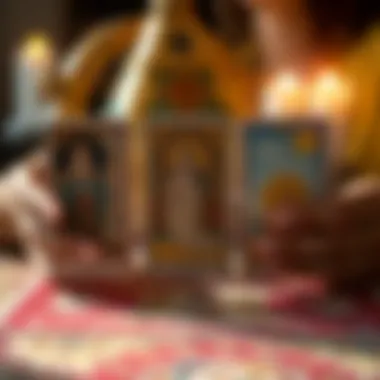
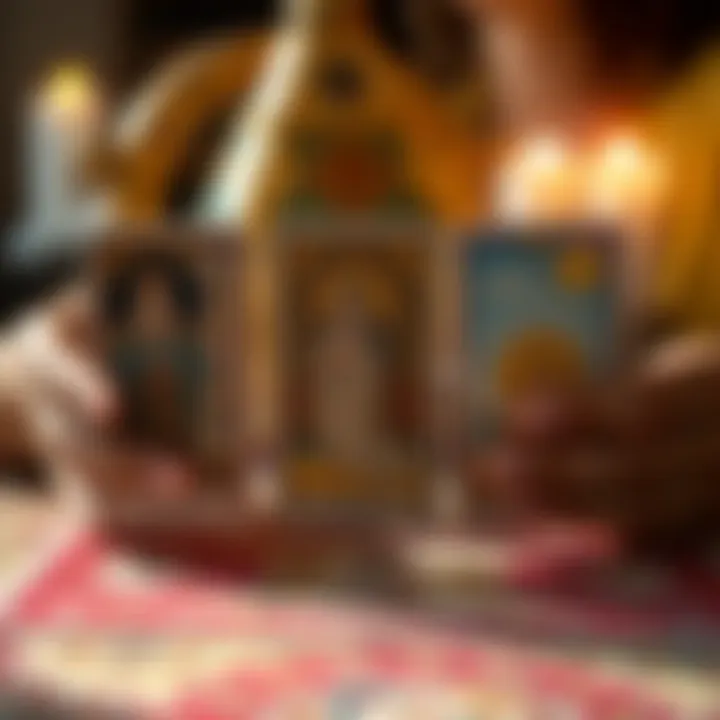
In essence, a thoughtfully constructed layout offers both the reader and the querent a lens through which to examine life’s complexities, making it a cornerstone of effective tarot practice.
How Layouts Influence the Reading
Card layouts are not random; they are strategic constructs that can alter how a reading unfolds. Each layout has its underlying principles designed to tap into distinct facets of life’s journey. For example, the Celtic Cross, often viewed as a comprehensive layout, addresses multiple dimensions of a question, from influences to challenges.
Conversely, simpler spreads like the Three-Card Spread can provide quick clarity while still allowing for deep insights. Here’s how layouts influence the reading:
- Shape Perception: A circular layout might suggest connections and interdependence, while a linear one may highlight progression and change over time.
- Focus Areas: Certain layouts emphasize specific aspects over others; relationship spreads tend to explore emotional dynamics, whereas career spreads might center around ambition and growth.
- Time Frames: Some formations intuitively relate to time, allowing readers to perceive changes over past, present, and future arcs.
In the end, how a spread is arranged can significantly change both the atmosphere of the reading and the takeaway insights.
Creating a Narrative Through Card Positioning
Crafting a narrative with tarot cards hinges on their placement within a layout. Every card’s location tells a story that aligns with the question being asked. This narrative approach enables the reader to weave together a coherent tale from seemingly disparate pieces of information.
- Sequential Positioning: In spreads that employ a sequence, like the Three-Card Spread, the order in which cards appear informs the evolution of the story. The first card may set the stage, while subsequent cards build the conflict or emotions leading to resolution.
- Contextual Role: When cards are positioned concerning each other, their messages may change dramatically. For instance, a positive card adjacent to a challenging one can signify the strength needed to overcome adversities, thus framing a narrative of resilience.
- Thematic Elements: Each position can represent a theme. In a Relationship Spread, one card might symbolize communication, while another addresses emotional support. Together, they create a full picture of a partnership.
Using card positioning to develop a narrative not only makes the reading more relatable but also allows the querent to engage with their situation on a deeper level. It fosters reflection and encourages personal insights that can stimulate growth and understanding beyond the reading itself.
Common Tarot Card Formations
In the complex realm of tarot, the way cards are laid out is essential. Each formation, or spread, serves a particular purpose, guiding the reader to derive insights that may be instantly visible or hidden beneath the surface. By engaging with various layouts, tarot practitioners are not merely shuffling cards; they are assembling a narrative, mapping energies, and unearthing vital discoveries about themselves and others. This section illuminates several common tarot formations, giving readers a clearer understanding of how these layouts can transform a simple reading into something profound.
The Celtic Cross Formation
The Positions Explained
The Celtic Cross is arguably the most renowned tarot spread. It includes ten positions which convey answers, challenges, influences, and the potential future paths available to the querent. Each position targets a specific aspect of the question at hand. For instance, the first position reveals the heart of the issue, while the second showcases the immediate challenge. The layout allows a detailed exploration of complex queries, making it a beneficial choice for those seeking to navigate multifaceted situations. Its unique feature lies in the depth it offers; as many are drawn to its intricacies, it can be overwhelming for beginners.
Common Interpretations
When interpreting the Celtic Cross, consistent themes emerge, offering a broad array of perspectives based on the fortunes and misfortunes indicated by the cards. Practitioners often find recurring insights regarding emotional undercurrents or practical obstacles. This spread is celebrated for its rich storytelling ability, offering a narrative flow that resonates deeply with readers. However, it requires a grounded understanding of the cards to avoid misinterpretation, presenting a double-edged sword in its interpretations.
The Three-Card Spread
Past, Present, Future Analysis
The three-card spread is an uncomplicated yet powerful tool in tarot reading. Its structure boasts simplicity, allowing readers to draw insights across time by focusing on past influences, current challenges, and future potential. This formation works exceptionally well for quick readings, providing coherent answers without overcomplicating matters. A distinctive feature is its adaptability; it can also be molded to focus on different aspects, such as mind-body-spirit or situation-action-outcome, enhancing its utility in various contexts. Nevertheless, readers must be cautioned; its brevity may gloss over essential details that a more elaborate spread might unveil.
Variations of the Spread
What makes the three-card spread fascinating is its versatility. Readers often experiment with different variations, from focusing on relationship dynamics to decision-making dilemmas. Each variation pivots the reading toward unique inquiries, making it a favored choice among practitioners of all experience levels. An advantage is its flexibility; with just three cards, nearly any question can be approached. Yet, this can also be a disadvantage, as it might lead to simplistic readings for complex issues.
The Horseshoe Spread
Understanding the Layout
The Horseshoe Spread presents seven cards in a semicircular layout, each representing a different aspect of the querent's life or query. This spread is particularly popular for its clarity and systematic approach. Its form encourages reflection on various influences, such as hopes, fears, and outcomes. This structured layout is appreciated for its straightforward visual representation, inviting querents to reflect deeply on each card's messages. Nevertheless, its linear nature might limit exploration in some situations where emotional nuance plays a crucial role.
Applications in Decision Making
Due to its clarity, the Horseshoe Spread is an excellent choice for decision-making scenarios. Each card can signify steps to take, potential hurdles, or outcomes related to the available options. Practitioners often note that this spread encourages a clearer pathway to navigate uncertainty. Its systematic approach helps to ease decision fatigue by collating essential influences into a single reading. However, it might not provide the richness of detail that other, more complex spreads can yield, especially in intricate situations involving many variables.
The Relationship Spread
Understanding Dynamics
The Relationship Spread focuses on interpersonal connections, whether romantic, familial, or platonic. Its layout typically assesses the dynamics between two people, analyzing feelings, barriers, and necessary growth areas. This spread is ideal for exploring the depths of connections, giving clarity on how one party affects the other. While it has proven beneficial for many, there's a cautionary note: the intricacies of human relationships may not fully be represented in a single spread, and it requires sensitivity in interpretation.
Exploring Compatibility Insights
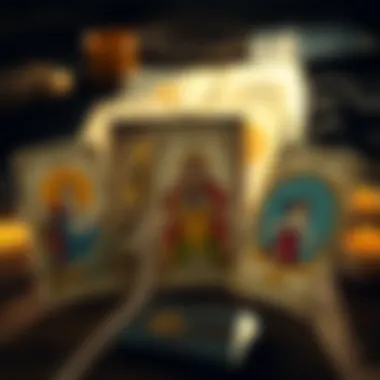
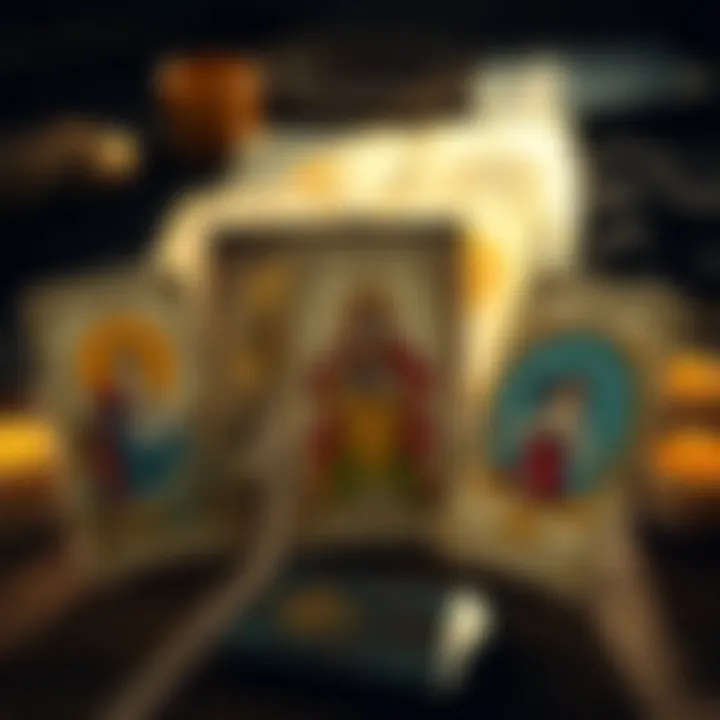
In exploring compatibility, this spread shines by detecting patterns and behaviors that may affect the relationship's health. It helps individuals ascertain not only the compatibility but also the challenges that could arise between two individuals. Aspects such as mutual desires and communication styles become clearer, offering valuable insights into improving the connection. However, like all tarot readings, the insights drawn depend heavily on the querent's openness and mindset, which can shape the effectiveness of the guidance offered.
The Single Card Draw
Focused Questioning
The Single Card Draw is one of the most fundamental approaches in tarot. By pulling one card to seek guidance, it invites a focused question, allowing the querent to gain insight swiftly and concisely. This method offers clarity and simplicity, making it an inviting option, especially to beginners. A key characteristic of this approach is its immediacy—by honing in on a specific inquiry, the querent receives a clear and direct answer. However, this straightforwardness might lead to surface-level interpretations, lacking nuance compared to more elaborate spreads.
Utilizing Daily Draws
Many enthusiasts incorporate the Single Card Draw into their daily routines. This practice fosters ongoing reflection and helps develop a closer relationship with the cards. By dedicating time for daily draws, querents can track their growth, enhance their understanding of recurring themes, and promote mindfulness. A unique feature of this approach is that it encourages impulsive questioning which can lead to surprising insights. That being said, it may require discipline to ensure that daily reflection becomes a consistent habit rather than a sporadic activity.
Remember, the beauty of tarot lies in its adaptability. Flexing your approach towards each spread can reveal the myriad layers of insights waiting just beneath the card's images.
Advanced Reading Techniques
In the realm of tarot reading, advanced techniques offer layers of complexity and depth that can enrich the overall experience. Understanding these methods is essential, as they help refine the reader's intuition and insight, ultimately leading to more precise interpretations. As the landscape of tarot evolves, so too do the methodologies employed by practitioners, making it vital to stay abreast of innovative approaches. This section will flesh out two significant advanced techniques: combining card formations and interactive spreads.
Combining Card Formations
Multiple Layers of Insight
Multiple layers of insight is a concept that brings together various card formations to create a more comprehensive narrative. This technique allows tarot readers to weave together stories from different layouts, enriching the interpretation process. By using multiple formations simultaneously, one can extract a nuanced understanding from seemingly straightforward cards.
One key characteristic of this approach is the mishmash of perspectives it offers. When you gather data from several layouts, you tend to see the bigger picture instead of being trapped in just one narrative. This broader view is particularly beneficial when tackling complex life situations where a single spread just won't cut it. If you are navigating through challenges at work and in personal life simultaneously, combining card formations can grant clarity.
However, there are some pitfalls to consider. Mixing too many spreads can lead to confusion, like trying to watch several movies at once. Keeping the focus sharp while utilizing multiple layers is essential to avoid information overload. Thus, skillful balance is necessary, making this technique both advantageous and sometimes tricky.
Complex Questions and Situations
The exploration of complex questions and situations is yet another facet where advanced techniques can shine. This aspect is crucial when querents bring forth intricate dilemmas requiring detailed resolution. Complex situations often involve mixed emotions, diverse components, or multiple stakeholders, making precise interpretation paramount.
Its key characteristic is the depth it provides. Instead of offering surface-level insights, delving into the aspects of a problem allows for a more meticulous reading. This method is particularly popular for readers who wish to address relationship conflicts or career crossroads. Understanding the intricate dynamics of these questions can lead to improved decision-making.
Yet, there are challenges that come with it too. Complex questions can at times induce uncertainty in both reader and querent. The ability to navigate through ambiguity and provide clarity requires a seasoned reader who is comfortable with vagueness. The insight gained is incredibly valuable, but it can also lead to emotional stress if not handled carefully.
Interactive Spreads
Incorporating the Querent's Energy
Incorporating the querent's energy into readings offers a more participatory approach, enhancing the connection during a tarot session. This technique enables the querent to infuse their intentions and vibrations into the reading, arguably leading to more tailored insights. By fostering this energetic exchange, readers can better tune into the nuances of the querent's needs and desires.
A defining characteristic of this option is its interactive nature. It transforms passive readings into collaborative experiences, where querents feel actively involved. This sense of ownership can lead to deeper revelations as they contemplate their circumstances deeply. Plus, it can help readers build a better rapport with those they are serving, ultimately fostering trust.
On the flip side, the integration of querent energy also demands skill. An inexperienced reader might unintentionally sway the reading based on their own biases or interpretations, misaligning insights from the actual energy present. Therefore, awareness of one's own energies is crucial in this process to ensure authenticity.
Real-Time Adjustments
Real-time adjustments bring dynamism to tarot readings. This approach enables the reader to modify interpretations on the fly based on the querent's reactions and responses. As they engage in conversation with the querent, readers can identify shifts in emotions or understanding, allowing for a more responsive reading.
The hallmark of this technique is its adaptability. It allows for a fluid exchange between reader and querent, resulting in a reading that resonates more profoundly due to its customizability. This flexibility can turn what might appear as standard interpretations into personalized journeys of self-discovery.
However, such adaptability does require skill in reading the room. If a reader takes too long to adjust based on energy shifts, they could lose the thread of the reading. Thus, it requires keen observation and quick thinking to apply this method effectively. Balancing responsiveness and maintaining the integrity of the reading is key.
The art of tarot lies not only in the cards drawn but in how readers interpret and navigate through their intricate tales.
Tips for Effective Tarot Readings
When diving into the world of tarot readings, it’s essential to focus on how you approach them. The right mindset and tools can transform a reading from merely routine to profoundly insightful. In this section, we explore several tips for effective tarot readings, emphasizing the importance of setting intention, maintaining an open mind, and documenting your experiences.
Setting Intention Before the Spread
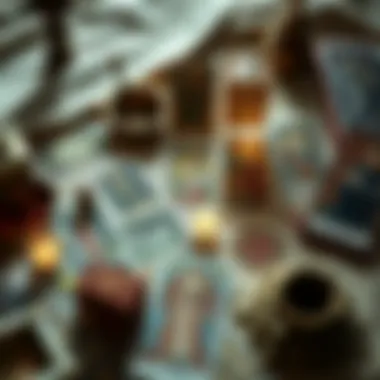
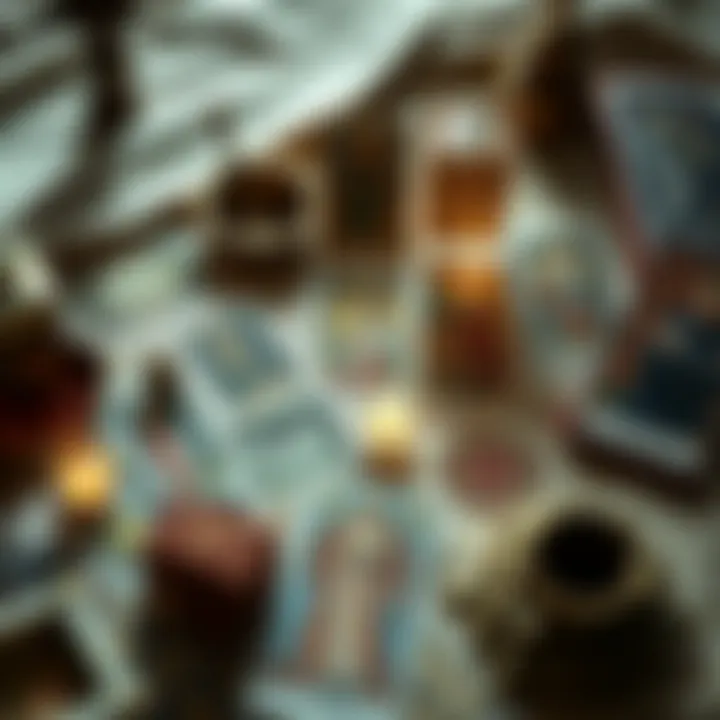
Before laying down the cards, take a moment to clarify what you seek from the reading. Setting intention is like tuning your radio to the right station; it helps to focus your energy and thoughts towards a specific inquiry. When you know what you are asking, every card drawn holds more meaning.
To establish your intention, consider the following:
- Be specific. Instead of asking vague questions, pinpoint what’s on your mind. Think along the lines of "What do I need to know about my career path right now?" rather than just "What’s coming up for me?"
- Visualize your inquiry. Picture the situation. This helps ground your thoughts and aligns your subconscious with the reading.
- Write it down. Documenting your question can help anchor your focus, making you more aware as you interpret the spread. It also provides a reference point for later reflection.
"A focused mind draws clear answers from the chaos of the cards."
Maintaining an Open Mind
Every tarot reading is a dance between the cards and your intuition. Keeping an open mind enhances your receptiveness to unexpected insights.
Here are some ways to foster an open mindset:
- Set aside preconceived notions. Avoid entering the reading with rigid expectations about outcomes. Cards may reveal truths that differ from what you want to hear.
- Embrace ambiguity. Sometimes a card's message isn’t immediately clear. Allow time for thoughts to develop naturally rather than forcing an interpretation.
- Stay curious. Approach each card with wonder. Questions can arise from surprises, leading to deeper insights. Ask yourself how this card relates to your unique situation.
Documenting Your Readings
Documenting your tarot readings is like keeping a map through the winding forest of your subconscious. This practice not only reinforces learning but also allows you to reflect on your growth over time.
Understanding Growth Over Time
Tracking your readings can illuminate patterns and trends that emerge over the months or years. As you look back, you might notice:
- Recurring themes. Certain cards may show up repeatedly, signaling areas of your life needing attention.
- Evolving insights. What you took away from one reading might shift in another context. This dynamic nature reflects personal growth and changing perspectives.
- Progression in questions. Observing how your questions evolve indicates deepening self-awareness.
The key characteristic of understanding growth over time is its capacity to inform your present. By recognizing where you've been, you gain clarity on where you’re headed, making it a wise choice in the realm of tarot.
Creating a Personalized Tarot Journal
A tarot journal is not just a collection of past readings; it’s a tool for personal exploration and growth. This document can include your questions, card interpretations, and reflections.
Here are specific aspects of maintaining a tarot journal:
- Unique feature of customization. Tailor your journal to suit your style. Some prefer simple notes, while others might sketch or use stickers. The way you journal should inspire you.
- Flexibility in format. There’s no one way to journal. You can log daily draws, monthly reflections, or major life events. Choose whatever method feels most right for you.
- Advantages of personal insight. Over time, the journal offers a treasure trove of wisdom, mirroring your growth and shifts in understanding. You may find yourself revisiting older entries, gaining clarity from past insights.
In the journey of tarot reading, these tips serve as guideposts, steering practitioners toward more meaningful experiences. Each tip, from setting intention to documenting experiences, contributes to a well-rounded practice that can enhance one’s understanding of both the cards and oneself.
Ending: The Art of Tarot Formations
The world of tarot reading is not a static landscape. It ebbs and flows, shaped by the hands of its interpreters and the contexts in which they operate. In our exploration of tarot card formations, we've seen how layouts do not just merely serve as a backdrop to readings; they are the language through which insights emerge. The formations themselves provide a structure, lending weight to the messages that the cards convey.
Understanding tarot formations is akin to mastering a unique dialect. Each configuration has specific meanings that can be deeply personal to the reader and the querent. Readers can unlock layers of insight and understanding, guiding seekers toward deeper reflections and more informed decisions in their lives. By learning the nuances of these layouts, practitioners cultivate a richer, more nuanced engagement with the cards.
Many consider tarot a tool, but it is really a mirror reflecting our inner landscape. The success of any reading relies on the ability to interpret the cards in relation to their positions within a formation. This synergy between the cards and their placements can shed light on even the most perplexing issues. In this way, tarot becomes a dynamic conversation rather than a one-way lecture.
“Tarot is a communication of shuffling thoughts and feelings, organized by layers of cards.”
The Evolving Nature of Tarot Practices
Tradition has its charm, but evolution brings vitality. As new generations of tarot readers come onto the scene, the practice constantly undergoes reinvention. Once rigid meanings may become more fluid, adapting to contemporary life’s unique circumstances and challenges. This adaptability makes tarot relevant across cultures and eras.
Moreover, the access to diverse resources—books, online communities, and even social media platforms—has broadened the horizons of tarot. Readers can explore various cultural interpretations and personal practices that enrich their understanding and approach. It becomes a multi-faceted tool, suitable for introspection, guidance, or even entertainment, depending on what the querent seeks.
In this context, appropriateness is a factor worth noting. Readers must consider elements that resonate with their personal beliefs and the cultural significance behind certain practices. In the end, the enriching nature of tarot lies in its evolving tapestry, stitched together from threads of history, intuition, and personal exploration.
Encouraging Personal Exploration
Tarot invites a personal journey; it offers a pathway to delve into the multifaceted nature of one's self. As the cards come alive through the reader’s insights, they can reveal motivations, desires, and fears that often reside in the shadows of the mind. This self-exploration can foster growth, compassion, and understanding toward oneself and others.
Consider not just the answers the cards provide, but the questions they evoke. Each reading can serve as a launchpad for deeper inquiry into personal narratives; what does this card represent in my life? or how does this placement reflect my current state? Reflective practices enhance the reading experience, as they facilitate a dialogue not just with the cards, but also with the self.
Encouraging such exploration includes creating a safe space where one feels comfortable confronting vulnerabilities. This nurtures an individual’s connection to tarot and turns the cards into a trusted ally on their journey toward self-discovery and resolution.
Creating a personalized tarot journal can help track this evolution, capturing insights, growth, and patterns over time. This practice not only reinforces understanding but also crystallizes epiphany moments, enriching the tarot relationship.
As tarot continues to evolve while remaining rooted in its rich history, it's a testament to how ancient practices can adapt and resonate powerfully within contemporary society. By grasping the art of these formations and embracing personal exploration, both seasoned readers and novices can find their unique style of engagement, turning tarot into a deeply personal, transformative experience.



